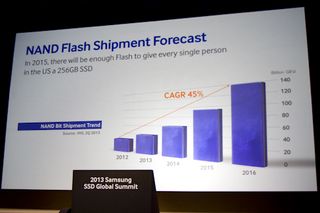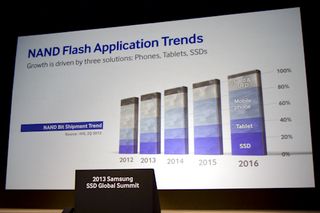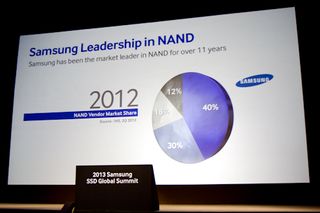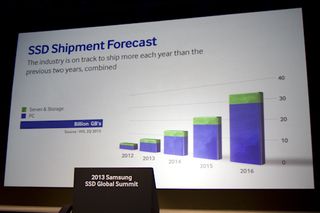Samsung's SSD Global Summit: The Leader In NAND Speaks Up
The theme of this year's Samsung SSD Global Summit, in Seoul, Korea, was SSDs For Everyone. More than 100 journalists from around the world showed up for this one-of-a-kind event, where we got a taste of the future in solid-state storage.
Samsung: Flexing Its Dominance In The NAND Market
Last month, Samsung held its annual SSD Global Summit in Seoul, South Korea. More than 100 journalists from around the world were present. Tom's Hardware sent its U.S. and German teams to learn more about the company's 840 EVO, which we reviewed in Samsung 840 EVO SSD: Tested At 120, 250, 500, And 1000 GB, a handful of drives that aren't available yet, and upcoming storage technologies expected to dramatically change the performance characteristics of next-gen devices.
The summit began with a little background on Samsung. This shouldn't come as a surprise to anyone who has ever purchased an SSD, a phone, a notebook, a TV, a refrigerator, built an oil refining plant, or insured a car in South Korea, but Samsung is a very big conglomerate with many different businesses. It pulled in more than $180 billion dollars in revenue last year.
There's no way to attribute the company's success to any one industry, but heavy investment in NAND research and production is certainly a big reason why it's doing so well in the semiconductor space.

Consider the sheer magnitude of current and future NAND shipments. In 2013, there will be 40 billion gigabytes of flash that ship out, or 40 EB (exabytes), a four with 19 zeroes behind it. At a compound annual growth rate (CAGR) of 45%, NAND shipments should hit 140 EB by 2016.

Of course, not all of that NAND is destined for SSDs. Only 16% of it went into solid-state drives last year. By 2016, Samsung predicts that number will rise to nearly 26%, with the majority of flash memory going into mobile phones.
The market share numbers give us a pretty telling story about Samsung's position in this space.

As of 2012, Samsung claimed 40% of the total NAND market. It's a familiar position for the company, which has held that crown for the past 11 years.
Stay on the Cutting Edge
Join the experts who read Tom's Hardware for the inside track on enthusiast PC tech news — and have for over 25 years. We'll send breaking news and in-depth reviews of CPUs, GPUs, AI, maker hardware and more straight to your inbox.

When you break down the SSD forecasts according to segment, it's clear that the PC space dominates. The enterprise-oriented server storage market isn't as large, naturally. But it's expected to grow over the next several years.

Samsung says its drives will be in six out of every 10 PCs that ship in 2013. Solid-state drives like the 840 Pro grab headlines, but it's the company's OEM business moving volume. The most recent example is Apple's MacBook Air featuring a Samsung-manufactured PCI Express-based SSD that caught a lot of people by surprise.
Current page: Samsung: Flexing Its Dominance In The NAND Market
Next Page Life Beyond SATA And AHCI-
ojas Well, i have 2.3 TB of writes and 4.36 TB of reads on my 120GB Intel 320 series SSD in the last year...no re-allocated sectors thus far.Reply
My 840 has about 0.41TB written to it, and i bought this drive a few months ago.
Anyway, looking forward to RAPID. -
Someone Somewhere @radiovan I read it as being that it's a replacement for AHCI/IDE - it'll still work with SATA.Reply
Anyone else find that this reads like an infomercial? -
Steveymoo Ahh Samsung, you're still not immune to the age old marketting technique of combining large breasted women with your technology, to catch men's eyes.Reply -
Onus Organizations with huge amounts of data to sift (e.g. Google, NSA, IRS) will want any speed they can get. Labs doing FCAT testing need ridiculous write speeds. For the rest of us, as individuals, if a bloated application like Word already loads in the blink of an eye, any faster simply doesn't matter. I hope a substantial focus can be placed on cost.Reply -
JPNpower CPUs GPUs are sort of slowing. this is the future. This is innovation at its hottest and fastest. Maybe it is competition as some say, as AMD is bogged down in processors, giving the leaders a healthy lead, but in flash, Samsung, Sandisk/Toshiba, and Micron are hot at it.Reply
Everyone wins. -
jabliese radiovan and SomeoneReply
NVMe is a protocol to work with PCIe. This is quite clear from the slides. What is PCIe? Do you remember your last video card upgrade? The slot your card plugged into was most likely a PCIe slot. NVMe has no business with SATA, and that's the way you want it to be. -
drewriley Reply11318974 said:No word on when we might be seeing the new vertical NAND in products?
Last year, Samsung touched on some new technologies that they were working on, but didn't share any insight during their latest summit,
Most Popular

